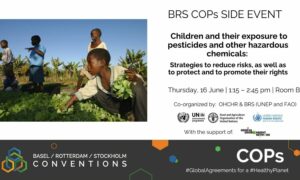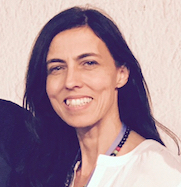Event
Children and their Exposure to Pesticides and Other Hazardous Chemicals | BRS COPs Side Event

16 Jun 2022
13:15–14:45
Venue: CICG | Room B & Online
Organization: Basel, Rotterdam and Stockholm Conventions, United Nations Office of the High Commissioner for Human Rights
This side event to the 2022 meetings of the Conference of the Parties to the Basel, Rotterdam and Stockholm Conventions (BRS COPs) was organized by the Office of the High Commissioner for Human Rights (OHCHR) together with the UNEP and FAO parts of the BRS Secretariat/s with the support of the Geneva Environment Network.

About this Session
This event aims at allowing discussions, across relevant stakeholders, on risk exposure of children as one of the groups in most vulnerable situations, and on approaches to prevent and remedy such risks, including through human rights-based approaches (HRBAs) to the environmentally sound management and disposal of hazardous chemicals and wastes, with a particular focus on children’s human rights.
Addressing the effects that environmental factors, in particular in the agricultural sector with pesticides, may have on children, an adequate protection of their wellbeing, of their health and lives, requires a human-rights based approach i. e. by strengthening the protection and promotion of children’s rights, including their right to a healthy environment and their right to meaningful and informed participation, via the fulfilment of international legal obligations subscribed by States, including BRS Conventions’ Parties themselves, as well as of business responsibilities. In June 2021, heads of UN entities affirmed their joint commitment to promoting the rights of children, and youth to a healthy environment and their meaningful participation in decision-making at all levels, in relation to climate action and climate justice. On 8 October 2021, in its resolution 48/13, the Human Rights Council adopted a landmark decision and recognised for the first time, that having a clean, healthy and sustainable environment is a human right, in particular for those in vulnerable situations, calling on States around the world to work together, and with other partners, to implement this newly recognised right.
Speakers

Christine FUELL
Senior Technical Officer and Coordinator, Secretariat of the Rotterdam Convention, FAO

Maria LEE
Child Labour in Agriculture Specialist, FAO

Rima EL CHIHNY
DNA, Rotterdam Convention of Lebanon | Ministry of Agriculture, Plant Pharmacy Department involved in Pesticide Registration.

Mikiko OTANI
Chair, United Nations Committee on the Rights of the Child

Desiree NARVAEZ
Environmental Health Specialist and Technical Lead, UNICEF’s Healthy Environments for Healthy Children global framework

Isabelle KOLEBINOV
Policy and advocacy coordinator, Child Rights International Network (CRIN)

Kirill BUKETOV
International policy officer for campaigns against forced labour, child labour and discrimination, International Union of Food and Allied Workers' Associations (IUF)

Diana RIZZOLIO
Coordinator, Geneva Environment Network | Moderator
Highlights
Key messages from the event and quotes are available on our Twitter account.
As #agriculture is one of the most dangerous employment for children, there is a need to raise the awareness of the risk of pesticides to the health of children to protect their rights, says Christine Fuell of @FAO.#BRSCOPs #ReducingRisksForChildren pic.twitter.com/MpYTwdgcIw
— GENeva Environment Network (@GENetwork) June 16, 2022
Summary
Welcome
Diana Rizzolio | Coordinator, Geneva Environment Network
The discussion focuses on the risks of exposure of children to pesticides, and approaches to prevent and remedy such risks. This is particularly through human rights-based approaches to the environmentally sound management and disposal of hazardous chemicals and wastes, with a particular focus on children’s human rights.
Geneva, the city for human rights, hosts various human rights bodies, including the UN Human Rights Council currently holding its milestone 50th session. In this city, we have seen many instances that have addressed such an issue, providing a backdrop against which the discussion can be enriched:
- In October last year, the Council in a landmark decision, recognised for the first time that having a clean, healthy and sustainable environment is a human right (resolution 48/13), in particular for those in vulnerable situations, calling on States around the world to work together, and with other partners, to implement this newly recognised right.
- In June last year, the heads of UN entities have affirmed their joint commitment to promoting the rights of children, and youth to a healthy environment and their meaningful participation in decision-making at all levels.
- The 110th International Labour Conference also recently concluded with adopting a resolution to add a safe and healthy working environment to the existing four Fundamental Principles and Rights at Work.
- The topic is also followed in depth by the Special Rapporteur on human rights and toxics, Marcos Orellana, who has been denouncing deplorable practices by some wealthy States of exporting domestically banned toxic chemicals, including pesticides, to third world countries.
- The Special Rapporteur has also been urging action to address alarming increase of child labour in agriculture sector, where they are exposed to toxic chemicals, including highly hazardous pesticides.
Opening Remarks
Christine Fuell | Senior Technical Officer and Coordinator of the Secretariat of the Rotterdam Convention at FAO
Children are one of the most vulnerable groups to pesticide exposure. Approaches, including human rights-based ones, to prevent and remedy such risks and to foster, environmentally sound management and disposal of hazardous chemicals and waste must be strengthened.
Agriculture is one of the most dangerous employment sectors, particularly for children below 18 years old. Today, 160 million boys and girls, almost one in ten children worldwide, are engaged in child labor, and the agricultural sector (crop farming, fisheries and aquaculture, aquaculture, livestock and forestry accounts, etc.) account for more than 70% of all child labor. Pesticides and agrochemicals also pose serious risk to their health.
People being deprived of fundamental human rights are more likely to be forced to choose between health and income. In rural areas, farmers are often poorly protected under labor law. They lack access to health information, training services, and personal protective equipment required to adequately respond to house assets.
Child labor is a serious violation of human rights, defined as work that is inappropriate for a child’s age as it interferes with children’s education and is likely to harm their health and safety. However, many vulnerable families worldwide have no choice but to engage children in work and prevent them from going to school because they need income or contribution to survive. Since child labor is predominantly found in the agricultural sector, addressing children’s exposure to pesticides and other hazardous chemicals should be made a top priority.
The international arena has recently been advancing the human rights agenda in connection with the environment, and potential actions and partnerships must be leveraged for national stakeholders to reduce children’s exposure to pesticides.
- The Rotterdam Convention prioritization of sound management of pesticides and hazardous substances as part of the full enjoyment of human rights, in particular children’s rights.
- UN entities’ announcement of a joint commitment to promote the rights of children and youth to a healthy environment
- Adoption of a landmark decision and recognized by the Human Rights Council the human right to a clean, healthy and sustainable environment.
We must identify areas where rights-based approaches have major impacts on the implementation of the chemicals and waste conventions like the Basel Rotterdam and Stockholm Conventions. It is also necessary to disseminate widely guidance and tools on pesticide management and exposure prevention.
Panel Discussion
Maria Lee | Child Labour in Agriculture Specialist, FAO
Agricultural work is one of the most hazardous occupations, where children may be exposed. Hazardous child labor is often invisible, and happens at a family level or in very informal settings, making it complex to pinpoint the areas to address.
At the end of the 5th Global Conference on the Elimination of Child Labor in Durban, South Africa, the Durban Call to Action was adopted to address various topics, including child labor and agriculture. This momentum is ripe for collective actions to find alternatives to pesticides and to end child labor at large.
Examples of Tools and Approaches. Child labor is a multifaceted and complex issue that requires an integrative approach and a combination of interventions. FAO has been developing and adopting some practical tools and approaches together with the Rotterdam Convention and succeeded in raising awareness and changing practices and behaviors.
- Community-level action must be coupled with national and global level interventions. The pesticides visual tools developed by FAO and ILO with the collaboration of the Rotterdam Convention has been a success in many countries and started a dialogue with households of farmers, parents and children on how to identify risks and potential alternatives. It is based on three elements: an understanding of how children are exposed to pesticides in direct or indirect way; presenting the negative effects of pesticides on health and human development, showing why children are at greater risk; and practical alternatives and solutions on what can be done to reduce children’s exposure to pesticides.
- Rural radios, and Dimitra Listeners Clubs (Mali, Burkina Faso and Niger) also bring together different members of the communities of all ages to discuss the issues the community is facing.
- FAO in Lebanon has developed an awareness campaign targeting young people and children through a free mobile app, developed with support from Plan International Lebanon. Promoting occupational safety and health for children and youth, it includes different messages connected to the components of pesticides and teaches the difference between what is dangerous and what is hazardous.
- The tool to enhance the capacity of agricultural stakeholders targets farmers, producer organizations, plant protection offices, extension agents, etc. FAO developed, in collaboration with the Rotterdam Convention, various capacities development programs at national, sub-regional and regional levels some activities. For instance, the farmer’s field schools are a participatory approach to bringing together different farmers to discuss and learn good agricultural practices and solutions to the problems they face.
- Awareness-raising initiatives of this kind have so far proven very effective and some of those modules on child labour were also integrated into some of the curricula of national programs.
We all have a role to play in eliminating hazards related to pesticides and protecting children. The collaboration between FAO and the Rotterdam Convention is a good example of a successful collaboration that allows to connect and disseminate different materials and guidance to different partners, public and private stakeholders. This collaboration plural actors of the labor, health, environment, and education worlds need to be included and take part in this conversation.
Rima Chihny | DNA, Rotterdam Convention of Lebanon | Ministry of Agriculture, Plant Pharmacy Department involved in Pesticide Registration
Agriculture is in the topmost hazardous sectors of child labor, especially through exposure to chemical hazards via: direct involvement in spraying; working in a recently pesticide-treated field; breathing pesticide from a nearby field; working in a pesticide-treated field without appropriate personal protective equipment (PPE); and eating with hands contaminated with pesticides .
In Lebanon, agriculture is estimated to comprise around 60 % of child labor, especially in rural areas and within the context of family farming. Since 2010 the complex Syrian refugee crisis has led to an increase in child labor, especially in its most abusive forms and conditions, notably in the Beqaa valley and the North of Lebanon.
Lebanese Legislation Addressing Child Work
- – The Worst Forms of Child Labour Convention, 1999 (No. 182), was ratified in 2003.
- – The government issued decree 1987 in 2012, which prohibits the employment of children under 18 years of age, where such harms that have safety or morals and limits education.
- – In 2017, a National Action Plan was developed to eliminate the most forms of child labor.
- – In 2006, Lebanon ratified the Rotterdam Convention. Being a party to Convention keeps us aware of pesticide risks to human health and the environment through facilitating the exchange of information on hazardous chemicals and providing technical assistance for the management of pesticides.
In the framework of the Rotterdam Convention, FAO regional office in the Near East and North Africa organized in September 2021 a mini-course to raise awareness of the dangers of pesticides to child labor. The output and recommendation of training were then addressed at high-level discussions on how to address hazardous child labor.
In 2017, the guidebook “Child labour in agriculture in Lebanon” was produced by FAO and ILO, providing a guide for practitioners in English and Arabic. This resulted in the further development of capacity-building programs and activities in the agricultural sector in the Beqaa and North Lebanon, and an assessment of the situation of children working in this sector in Beqaa.
Occupational Safety and Health (OSH) lessons have been developed and integrated into the official curriculum of agricultural high schools. This curriculum was implemented within the framework of FAO project “Upgrading the agriculture education system Agriculture education system in Lebanon” and it identifies the main challenges and risks related to the use of pesticides in agriculture to be considered as a priority for reducing the risk on the younger generation.
As most child laborers in agriculture are refugees, FAO, ILO and UNICEF published a storybook in Arabic for refugee children living in informal settlements. Its objective is to educate children about the risk and negative effects of pesticides and the protective measures to be taken.
FAO-ILO-UNICEF and national authorities developed a video presenting a visual guide to protecting youth aged 14-17 from harmful and not age-appropriate agriculture tasks. In 2022, an assessment of child labor and greenhouses in Akkar and Mount Lebanon was conducted by FAO and provides valuable data on the incidence and modalities of children’s exposure to pesticides and greenhouses.
The efforts to abolish child labor in agriculture in Lebanon must be continuous. Protecting children from pesticides requires a coordinated effort by all stakeholders from the level of policymakers right down to the level of employers and workers. This can be done by :
- Enforcing legislation by implementing national policy on the safety and health of children; enforcing the hazardous work list (Decree 8987) and clarifying that the application of pesticides should be prohibited for children; and increasing capacity of labor inspection systems in the rural and agricultural areas.
- Raising awareness by strengthening the role of agricultural extension officials in order to provide appropriate training on the impact of pesticides on children; and intensifying advertising and media campaigns to educate society about the danger of pesticides
Mikiko Otani | Chair, United Nations Committee on the Rights of the Child
The three pillars of the strategy to combat child labor are raising awareness; a multi-dimensional approach and the enhanced role of the Committee.
States and policymakers, along with international actors, must take a stronger and bolder action to understand the negative impacts of children’s exposure to hazardous materials and address it as a child rights issue. All environmental-related phenomena should be addressed as health and human rights issues. The child rights experts’ group must guide decisions and actions taken at different levels.
To increase awareness, the Committee on the Rights of the Child decided last year to draft a General Comment (No. 26) on children’s rights and the environment, with a special focus on climate change. This comment is targeting the Members of the Committee and aims to impact their policy and decision-making on the issue of environmental impacts and its effects on children.
Besides advancing a child rights-based approach, the General Comment and the work of the Committee praise and invite to embrace a multi-stakeholder and multi-sectoral approach to foster the right to a healthy environment for child labor. It is key to include the children’s rights perspective in the right to health and protection from child labor, in particular, the prohibition of hazardous child labor.
Child participation must be enhanced to ensure the protection and promotion of children’s rights that reflects experiences, true needs and challenges of the very same targets. The Committee on the Rights of the Child should play a more prominent role in advancing children’s inclusion as they monitor the implementation of the Convention in all Member countries. While it plays an enforcing role, the precious work of FAO, ILO and UNICEF, among others, is fundamental to gathering data to be repurposed to countries as targeted concrete action.
Desiree Narvaez | Environmental Health Specialist and Technical Lead, UNICEF’s Healthy Environments for Healthy Children global framework
Children have the right to a healthy environment in which they live, learn and play. UNICEF is active on many fronts, focusing especially on the prevention of infringement of these rights. The increasing use and unsound management of pesticides contaminate the environment that can be a source of hazardous exposure among children.
Children, especially those who live in agricultural settings, are particularly vulnerable to pesticides, which can cause lifelong and irreversible negative health effects. Urgent action is needed by all stakeholders to reduce environmental contamination from pesticides to protect children ’s health.
Use of Pesticides Increases Risk of Exposure in Children
UNICEF’s publication “Places and Spaces for Children” investigates children’s exposure to climate change and environmental hazards in OECD and EU countries. It revealed that one in twenty children lives in an area of high pesticide risk. Pesticides are one of the few toxic substances intentionally applied to the places children live, work and play. Children in both agricultural and urban settings are exposed to pesticide use, pollution, and contamination of food and drinking water. Those living in agricultural settings may have a higher risk of exposure due to take-home exposures. Stakeholders should consider that the intensive use of pesticides in an agricultural setting, amounting to high expenses, is not solving world hunger as 22% of the world’s children are stunted. Children’s exposure risks occur at every stage of development and depending on their ages, children can suffer effects like cancers, higher mortality due to ingestion of pesticides, decreased lung functions and more.
Actions Needed to Protect Children from Pesticides
1. Child-Centered Policies
- Creation of international standards for toxicity testing that consider the vulnerability of developing fetuses and children to hazardous substances
- Development of an official list of highly hazardous pesticides to streamline regulation and make them less accessible across international boundaries
- Design, implement and enforce public health, environmental, and labor laws to protect children’s right to a healthy environment, which they are entitled to by the Convention on the Rights of the Child
2. Effective Cross-Sectoral Education
- Increase knowledge across all stakeholders including private, healthcare, businesses and governments about the unique vulnerability of children to pesticide hazards
- Ensure farmer education on pesticide risks, the economic feasibility of reduced use, and use reduction strategies such as integrated pesticide management
UNICEF Response to Protect Children from Pesticides
- Launch of the Healthy Children for Healthy Environments Global Programme Framework in 2021 to promote and protect children’s health and rights and prevent exposure to environmental hazards and climate change.
- Development of a massive open online course on Children’s Environmental Health to increase the ability of health care providers to prevent, diagnose and treat diseases associated with environmental factors such as pesticides and build tools for successful advocacy.
- Development of inter-agency advocacy materials that illustrate the negative impacts of pesticides on children.
Isabelle Kolebinov | Policy and Advocacy Coordinator, Child Rights International Network (CRIN)
There is a lack of understanding of the linkages between exposure to pesticides and their effects on children’s rights. Child Rights International Network is a global policy and advocacy organization and its goal it to build a world where children’s rights are recognized, respected and enforced and where every child violation has a remedy.
Being free from the impacts of environmental degradation is children’s right and toxic and chemical exposures are infringing it. The participation of children to identify solutions to this issue is fundamental because they have the right to be heard and participate in matters that affect them. Every child that can develop his or her own ideas has the right to make them heard and influence decision-making processes that will impact their lives. States must include children and youth in decision-making processes.
This right is linked to the topic of consensus. States must prevent childhood exposure to toxic substances in recognition of the right of present and future generations to be heard. According to the right to bodily integrity, each human being has a right to autonomy and self-determination of his/her body, non-consensual intrusion like toxic exposure is a breach of this right. Prevention should be the primary approach followed by every state as a way to exercise their obligation to protect human rights.
The duty to prevent is reinforced by the resolutions on children and the environment urging states to ensure the enjoyment of everyone of the highest attainable standards of physical and mental health (42/16) and the recognition of the human right to a healthy, clean and sustainable environment for all (48/13). The right to non-discrimination is important because the diverging standards of production, use and protection from hazardous pesticides create double standards. Many states have domestically restricted or banned toxic substances but they continue to export them to foreign countries, violating children’s right to non-discrimination.
Access to justice: in the case in which they are harmed by toxic chemicals, children face many barriers to access justice, especially the burden of proof. Placing the burden of proof on victims of exposure promotes impunity and denies access to justice. States should consider recalibrating the burden of proof on those with greater access to information.
A children’s rights action plan should be developed on the model of existing ones within the BRS Secretariat, e.g., the gender action plan.
Video Message from Yousuf, Youth Climate Activist from Pakistan
I grew up witnessing people forced to migrate because of the impossibility to make a livelihood on the surrounding natural resources, either because of their overexploitation or their depletion related to climate change. Last year, 20 people in the region I live in died because of a cholera outbreak that originated from contaminated waters, which were their only option for drinking.
Children and poor people are more exposed to adverse and even fatal effects of overexploitation. They often are forced to migrate to find more livable conditions. These people should be offered safe and sustainable alternatives to conduct their lives, especially to grow their own food free of pesticide adverse effects.
Kirill Buketov | International policy officer for campaigns against forced labor, child labor and discrimination, International Union of Food and Allied Workers’ Associations (IUF)
The International Union of Food and Allied Workers’ Associations (IUF) is the major global organization for the protection of workers In the agricultural sector and it has existed for over a century. Priorities shift frequently and in the past decade, the campaign against child labor has been at the top.
The 110th International Labour Conference, held from 27 May to 11 June 2022, adopted a resolution to add a safe and healthy working environment to the existing four Fundamental Principles and Rights at Work (FPRW): the right of a working environment free of child labor, free of forced labor, which allows freedom of association and freedom from discrimination. If one of these rights is not respected, the others are likely to be absent as well. The right for workers to organize themselves is key to enabling them to eliminate additional violations of rights in their workplaces. For employers, this may seem threatening for increases in production costs.
As a result of the Durban Conference on Child Labor, others were organized and stressed the particular importance played by agriculture. Out of the 49 recommendations for immediate action, eight of these regarded agriculture. These aim at increasing workers’ awareness of the risks related to toxic pesticides. To overcome the initial skepticism such alerts might encounter, having workers that carry out this message can be very effective.
As reported by IUF African Coordinator, in Burkina Faso, IUF coordination conducted field visits and met with vegetable growers to show how to grow crops without pesticides. The community noted a significant increase in the number of vegetable growers investing in organic production. In Senegal, where vegetable workers suffered poisoning often until a few years ago, the IUF campaign using safety data sheets to track the use of pesticides and remedial measures needed resulting in a decrease in cases. In Mali, the IUF Coordination Committee organized a training program for vegetable growers focusing on best practices for pesticide use and alternatives.
There are plenty of other examples of worker activists spreading best practices to make workplaces safe. A safe workplace for workers means having a safe play field for children. If parents have decent wages, children do not need to work in a risky field as the agriculture one. Ensuring every worker, a decent wage is the top priority of IUF.
Q&A
Q: What actions has UNICEF undertaken after finding that one every three children are exposed to lead worldwide?
Desiree Narvaez: UNICEF is exercising a lot of pressure on the ground and using advocacy material to sensibilize over the issue of child exposure to lead and prevention. UNICEF is also encouraging surveillance through lead blood levels testing and environmental exposure testing. Advocacy is also done to convince ministers of the environment to develop legislation and policies to tackle lead exposure. The health sector cannot take up this challenge alone, therefore inter-agency collaboration is much recommended.
Q: Are the casualties mentioned by the young activist Yousuf related to pesticides?
Isabelle Kolebinov: The video was indicating that climate change affects the availability of resources and scarcity forces people to take unhealthy decisions.
Q: Kids are exposed to herbicides daily, not only if they are working in agriculture but also in their households, and some of these substances, like paraquat, are not listed under Rotterdam.
Small producers and household use of pesticide-contained materials (e.g., containers to store water) must be carefully monitored to tackle all aspects of children’s exposure.
Christine Fuell: While negotiations for the Secretariat to ban paraquat continue, so will the awareness-raising campaigns. The Rotterdam convention also stands ready to provide less hazardous solutions and alternatives. Listing is not the same as banning, but Parties to the Convention must be free to choose to continue using a substance or not after knowing the risk they incur.
Closing Remarks
Maria Lee: We must ensure that all communities know about the risks of being exposed to pesticides and of prevention measures. Awareness needs to be combined with practical alternatives and collaboration with different stakeholders.
Rima Chehny: The protection of children from hazardous pesticides requires the coordinated efforts of all stakeholders, from policymakers to children themselves.
Mikiko Otani: Multi-stakeholder dialogues should be expanded and held more frequently to reach a true solution to child labor. Children should be an integral part of these.
Desiree Narvaez: Children have the right to a healthy environment in which they live, learn and play and not be exposed to hazardous pesticides.
Isabelle Kolebinov: Children should be included in decision-making processes. Prevention of exposure should be the primary approach pursued by states. When violations occur, access to justice is critical and states must provide the means to redress to children.
Kirill Buketov: A safe workplace is free of forced labor and workers’ rights to organize should be recognized as central.
Christine Fuell: Everyone participating in today’s event have the privilege of knowing about hazardous pesticides, child labor and the need to end these practices. This privilege comes with the duty to raise awareness on that knowledge and start acting to end it.
Video
Documents
Additional Resources
- 2016 report of the Special Rapporteur on toxics and human rights (A/HRC/33/41)
- 2018 report of the Special Rapporteur on human rights and the environment (A/HRC/37/58)
- Resolution 47/24 on human rights and climate change, adopted on 14 July 2021
- Protect children from pesticides. Visual facilitator’s guide | FAO & ILO, 2015
